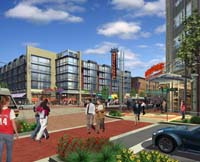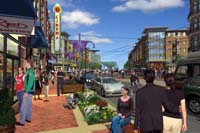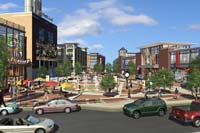 |
| Politics | Business | Schools | Justice | Health | Et Cetera |
Maryland Newsline Wednesday, Oct. 17, 2007; sketches added Oct. 18, 2007 If it worked in Silver Spring, why not in College Park? That was a point made by Douglas Duncan, former county executive of Montgomery County, during a public forum Tuesday night on the East Campus redevelopment project. The project would transform 38 acres owned by the university and sprawling across Route 1 and Paint Branch Parkway into a cultural center where people can work, live and play, said Duncan, now vice president for administrative affairs at the University of Maryland. It again teams up Duncan with developers Foulger-Pratt Companies and Argo Investment, which he worked with on the downtown Silver Spring redevelopment project. East Campus “will create a sense of place and an enduring legacy for the community,” said Richard Perlmutter, principal for Foulger-Pratt Argo, at the forum broadcast live over UMTV and moderated by journalism professor Lee Thornton. The proposed development would include 2,000 apartments for graduate students and others, a transportation center, 100,000 square feet of office space, and 400,000 square feet of retail space. A grocery store, hotel, movie theatre and retail shops are in the plans as part of the commercial space, along with the Birchmere, an Alexandria, Va.-based music hall that has featured artists such as Lyle Lovett, Linda Rondstat and Mary Chapin Carpenter. “When we announced Birchmere, for a lot of people, it suddenly became real,” Duncan said. The site, across from the main entrance to campus, now includes storage and maintenance buildings, a greenhouse, a bus depot, parking lots, and two undergraduate student housing complexes. Much of what is there now will be removed, Duncan said. Construction on East Campus may begin as early as 2009, with finished blocks being delivered between 2111 and 2115, Perlmutter said. Duncan advocated an even faster timetable, saying he’d like to get parts of the site open by 2010. Duncan also said the cost, projected at $500 million, may go as high as $700 million. He said he would look to the City of College Park and Prince George’s County for help, though funding will also be generated from private investments. Phase one of the project would include building retail and phase two would be mid-rise or smaller housing, Duncan said. Graduate Student Government President Laura Moore spoke on behalf of the appointed community steering committee as well as the blog, Rethink College Park. The blog was launched in 2006 by Maryland alumnus David Daddio and community planning master’s student Rob Goodspeed to promote discussion on smart development of College Park. “It’s hard to envision 38 acres and what it’ll look like in five to ten years,” Moore said. “It’s not something students can get a grasp of overnight.” Moore said her main concern is that housing be made available to graduate students. The roughly 1,000 new units proposed for grad students, she said, would be a huge addition to existing housing. Current graduate student housing options on campus only add up to 476 apartment units, said Jan Davidson, associate director of resident life. “We’re grad students, we’re poor, obviously. The price has to be kept down” for rent, Moore said. And housing has to meet students' diverse needs, she said. The 10,000 University of Maryland graduate students range from young adults who just completed their undergraduate studies to those in their 30s and 40s with families to feed. Concerns brought up by the handful of questioners who turned up for the forum included environmental impact, involvement from units within the university and traffic rerouting. Duncan said that the phase-by-phase development should limit construction traffic, but he had no estimate on how much traffic to expect. Moore said that more housing within walking distance of campus could reduce car trips. Perlmutter called the development an “interactive process” due to the involvement of the steering committee, which meets a few times a month to discuss each step. The public is invited to attend these sessions. “This is not a monologue,” he said. Moore said she is optimistic that East Campus development can help foster a good relationship between the university and College Park, especially since both sides are represented on the steering committee. Dieter Brill, a physics professor at Maryland who attended the forum, said afterward that he liked the presentation. “I think they answered the questions fairly and to the extent that they could,” he said. “They didn’t talk around the issue.” Maryland Newsline's Rachel Mauro can be reached at techgadgets-online@jmail.umd.edu.
|
||||||||||
|
Copyright © 2007 University of Maryland Philip Merrill College of Journalism | ||||||||||
| Politics | Business | Schools | Justice | Health | Et Cetera | |||||



 UMTV broadcast of the forum
UMTV broadcast of the forum